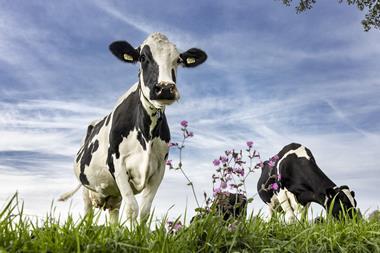The quest for added value is adding some cool to the milk shelf. Ed Bedington reports
Once upon a time, there was a pint of milk or a four-pint flagon - and that, to be frank was as exciting as it got. The last biggest innovation in the proverbial ‘white stuff’ was the arrival of skimmed and semi-skimmed, but since then, the sector has remained relatively quiet.
Well, not anymore. Since the start of the year, there has been a flurry of activity on the milk front with new products hitting shelves.
“There’s a clear focus among British dairy companies on the development of added value products,” says Jim Begg, director general of the Dairy Industry Association.
And that certainly has an effect on the shelves. Three major branded products have recently been launched into the milk sector.
Leading non-dairy brand Flora Pro-activ announced its intentions to break into the milk market with a branded one-litre semi-skimmed pack. A week later, processing giant Robert Wiseman announced the arrival of a milk containing just 1% fat, supported by a £2m in advertising. Branded The One, the company hopes its striking purple colours will stand out in the traditional blue, green and red of the category.
Sandie Wilkie, the company’s sales and marketing director, says the product was aimed at retaining the taste and texture of semi-skimmed but with less fat.
“It’s all about meeting the increasing demand for choice from the consumer and if we can help overall milk consumption at the same time - even better.”
Meanwhile, Wales’ largest processor ACC Milk launched Cadog, the first Welsh dairy brand with fully bilingual labelling, following a £12m investment. The range, which includes butter, rice pudding, custard and milk, is packaged with a distinct Celtic logo and image. Alan Hinton, general manager, says: “Wales has fantastic natural produce and needs distinctive brands like Cadog.”
Dial’s Begg agrees: “Provenance is hugely important and a way to additional revenue.”
The recent flurry of activity is following a growing trend within the dairy category where more processors and dairies search for that elusive added value alchemy.
Arla was one of the first organisations to attempt to break the commodity barrier in fresh milk with the launch of Cravendale. The brand offered consumers longer life milk with a ‘clean, filtered’ taste. The product has performed consistently well and following its trial launch three years ago, has been rolled out nationwide.
Night Time Milk was launched earlier this year by St Helen’s Farm, following in the wake of Red Kite Farms’ Slumber Bedtime Milk. Both products claimed to contain higher levels of melatonin, a natural hormone that aids sleep which is found in higher quantities in morning milking.
Fresh milk is not the only category undergoing a revolution either. Milk Link hopes to take the long-life category by storm with the launch of its Moo range. Available in skimmed, semi-skimmed and whole UHT milk, the company claims 95% of the 800
people it surveyed could not tell the difference between fresh semi-skimmed and Moo. Brand manager Sarah Baldwin says: “Moo is fresh milk packaged to last longer.”
The retailers are welcoming all this activity. Jon Arnold, milk buyer for Sainsbury, says: “We support this product development as long as it has clear consumer benefits that are understood by our customers.” One recurring theme from the retailers given voice in The Dairymen, a supplement published by The Grocer last year, was the importance of innovation. Harvey Bennett, Asda’s chilled foods general manager, said at the time: “There’s good innovation in own label and branded which helps to drive good growth.”
But the real engine driving this juggernaut of innovation is the changing dairy environment, says Begg. “Nobody wants to be in commodity in the future, particularly not with the CAP reforms. People have to find more profitable uses for milk and they must get investment funds to stimulate that process, and that’s already happening.”
He points to the farmers who are working with the Milk Development Council and injecting £4m into a project to promote dairy innovation. Other organisations are investing in modern research facilities as well. “More will follow. After all, who wants to invest in markets that are so exposed to currency fluctuation?” he points out.
Once upon a time, there was a pint of milk or a four-pint flagon - and that, to be frank was as exciting as it got. The last biggest innovation in the proverbial ‘white stuff’ was the arrival of skimmed and semi-skimmed, but since then, the sector has remained relatively quiet.
Well, not anymore. Since the start of the year, there has been a flurry of activity on the milk front with new products hitting shelves.
“There’s a clear focus among British dairy companies on the development of added value products,” says Jim Begg, director general of the Dairy Industry Association.
And that certainly has an effect on the shelves. Three major branded products have recently been launched into the milk sector.
Leading non-dairy brand Flora Pro-activ announced its intentions to break into the milk market with a branded one-litre semi-skimmed pack. A week later, processing giant Robert Wiseman announced the arrival of a milk containing just 1% fat, supported by a £2m in advertising. Branded The One, the company hopes its striking purple colours will stand out in the traditional blue, green and red of the category.
Sandie Wilkie, the company’s sales and marketing director, says the product was aimed at retaining the taste and texture of semi-skimmed but with less fat.
“It’s all about meeting the increasing demand for choice from the consumer and if we can help overall milk consumption at the same time - even better.”
Meanwhile, Wales’ largest processor ACC Milk launched Cadog, the first Welsh dairy brand with fully bilingual labelling, following a £12m investment. The range, which includes butter, rice pudding, custard and milk, is packaged with a distinct Celtic logo and image. Alan Hinton, general manager, says: “Wales has fantastic natural produce and needs distinctive brands like Cadog.”
Dial’s Begg agrees: “Provenance is hugely important and a way to additional revenue.”
The recent flurry of activity is following a growing trend within the dairy category where more processors and dairies search for that elusive added value alchemy.
Arla was one of the first organisations to attempt to break the commodity barrier in fresh milk with the launch of Cravendale. The brand offered consumers longer life milk with a ‘clean, filtered’ taste. The product has performed consistently well and following its trial launch three years ago, has been rolled out nationwide.
Night Time Milk was launched earlier this year by St Helen’s Farm, following in the wake of Red Kite Farms’ Slumber Bedtime Milk. Both products claimed to contain higher levels of melatonin, a natural hormone that aids sleep which is found in higher quantities in morning milking.
Fresh milk is not the only category undergoing a revolution either. Milk Link hopes to take the long-life category by storm with the launch of its Moo range. Available in skimmed, semi-skimmed and whole UHT milk, the company claims 95% of the 800
people it surveyed could not tell the difference between fresh semi-skimmed and Moo. Brand manager Sarah Baldwin says: “Moo is fresh milk packaged to last longer.”
The retailers are welcoming all this activity. Jon Arnold, milk buyer for Sainsbury, says: “We support this product development as long as it has clear consumer benefits that are understood by our customers.” One recurring theme from the retailers given voice in The Dairymen, a supplement published by The Grocer last year, was the importance of innovation. Harvey Bennett, Asda’s chilled foods general manager, said at the time: “There’s good innovation in own label and branded which helps to drive good growth.”
But the real engine driving this juggernaut of innovation is the changing dairy environment, says Begg. “Nobody wants to be in commodity in the future, particularly not with the CAP reforms. People have to find more profitable uses for milk and they must get investment funds to stimulate that process, and that’s already happening.”
He points to the farmers who are working with the Milk Development Council and injecting £4m into a project to promote dairy innovation. Other organisations are investing in modern research facilities as well. “More will follow. After all, who wants to invest in markets that are so exposed to currency fluctuation?” he points out.








No comments yet